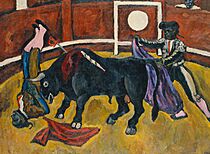Pyotr Konchalovsky facts for kids
Quick facts for kids
Pyotr Konchalovsky
|
|
|---|---|

Self portrait, 1912 (age 38)
|
|
| Born |
Pyotr Petrovich Konchalovsky
21 February 1876 Sloviansk, Izyumsky Uyezd, Kharkov Governorate, Russian Empire
|
| Died | 2 February 1956 (aged 79) |
| Nationality | Russian |
Pyotr Petrovich Konchalovsky (born February 21, 1876 – died February 2, 1956) was a famous Russian painter. He was part of an art group called the Knave of Diamonds. His paintings are known for their bright colors and bold style.
Contents
Discovering Pyotr Konchalovsky's Art
Early Life and Education
Pyotr Konchalovsky was born in a village called Slavianka in the Russian Empire. This was on February 21, 1876. His father worked with art, publishing books and translating. He knew many artists in Russia.
In 1889, Pyotr's family moved to Moscow. Their home became a popular spot for artists. Famous painters like Valentin Serov and Mikhail Vrubel often visited.
Pyotr studied art while he was in school. He went to classes at the Moscow School of Painting, Sculpture and Architecture. Later, from 1896 to 1898, he studied in Paris at the Académie Julian. In 1899, he returned to Russia. He joined the Imperial Academy of Arts in Saint Petersburg. He finished his studies there in 1907.
Starting His Art Career
Pyotr Konchalovsky first showed his art in Paris in 1908. He then came back to Moscow with new ideas. Some of his early works showed influences from a style called "Fauvism". This style used very strong, bright colors.
By 1909, he was showing his art often. He joined several art exhibitions. He also helped start a group called the Knave of Diamonds in 1909. This group was quite rebellious. They wanted to mix modern French and German art styles with older Russian art. Konchalovsky became the leader of this group in 1911.
Art After World War I
Pyotr Konchalovsky served in the Russian army from 1914 to 1916. After the war, he returned to painting. He started teaching art in 1918. In 1922, he had his first solo art show. It was held at the Tretyakov Gallery.
During this time, he mostly painted still lifes and landscapes. His paintings were still influenced by the artist Paul Cézanne. He also began painting portraits. These portraits are seen as examples of the socialist realism style.
Pyotr's Family Life
Pyotr married the daughter of the famous painter Vasily Surikov. Vasily Surikov greatly admired his son-in-law's art.
Konchalovsky's Artworks
Konchalovsky was a very busy painter. He created more than 5,000 artworks in his life. His art style changed and grew over time.
Before World War I, you could clearly see Paul Cézanne's influence in his paintings. Konchalovsky was known as a leader in Russian modern art. Later, he became a member of the U.S.S.R. Academy of Fine Arts. He was also named a People's Artist of the R.S.F.S.R. His paintings helped shape Soviet realistic art.
Pyotr Konchalovsky's Legacy
Many of Pyotr Konchalovsky's family members also became artists. His son, Mikhail Petrovich Konchalovsky, was a painter. His daughter, Natalia Konchalovskaya, wrote books for children. Her husband, Sergey Mikhalkov, was a famous poet. He wrote children's poems and the words for the State Anthem of the Soviet Union. He also wrote the words for the current National anthem of Russia.
Natalia and Sergey had two sons. Andrei Konchalovsky is a film director and painter. His son, Egor Konchalovsky, is also a film director. The other son, Nikita Mikhalkov, is also a movie director. In 1994, he won an Oscar for his film Burnt by the Sun.
In 2006, Pyotr Konchalovsky's family started a foundation. This group helps to keep his art and memory alive. They organize art shows and help confirm if artworks are truly his. A street in Moscow is even named after him.
Galleries
- Pyotr Konchalovsky paintings, pre-WWI
- Pyotr Konchalovsky paintings, Soviet period














